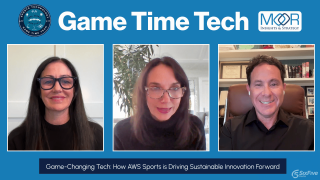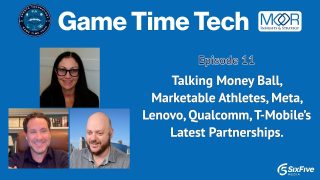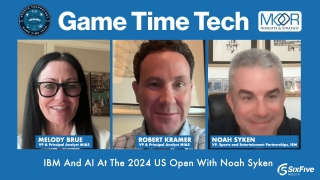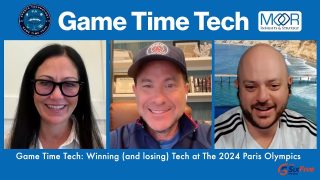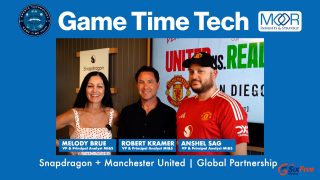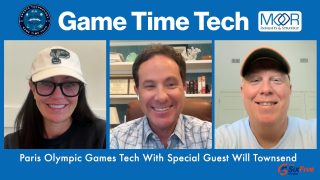On this episode of Game Time Tech, Hosts Melody Brue and Robert Kramer are joined by Jason Andersen to discuss the tech on display for the 2024-2025 NFL season. They also cover AWS, Cisco, Sony Electronics, Cadence Design Systems, and more!
Watch the video below:
Or listen to the audio here:
AWS
https://aws.amazon.com/blogs/media/how-ai-is-streamlining-seahawks-game-day-coverage/
https://aws.amazon.com/sports/nfl/seattle-seahawks/
Cisco
Sony
https://electronics.sony.com/sonyxnfl
Cadence
https://www.cadence.com/en_US/home/company/niners-partnership.html
Disclaimer: This show is for information and entertainment purposes only. While we will discuss publicly traded companies on this show. The contents of this show should not be taken as investment advice.
The Game Time Tech Podcast is a Moor Insights & Strategy Six Five Media production.
Transcript:
Melody Brue: Hi, welcome to this week’s edition of Moor Insights & Strategy Game Time Tech podcast. I am Melody Brue and I’m joined this week by my co-host, Robert Kramer. And we have a special guest this week, Jason Andersen. We are all actually vice presidents and principal analysts of different verticals but we all are here to talk about sports today, specifically NFL. And before we get started a little disclaimer, this show is for information and entertainment purposes only. While we will discuss publicly traded companies, its contents should not be taken as investment advice. So let’s get started. So topic number one, AWS. You two were just in Seattle with AWS for analyst event and a football game. Having a little FOMO, I have to admit. I was actually at a different event. I was at a very cool event in San Jose as … With Zoom. You guys I think maybe got the good end of the stick. Tell me about it.
Robert Kramer: I mean, I thought it was a great time. It’s always fun when you go to these events to meet people but also to see the game, but how the game’s using technology. Jason and I got to see it firsthand which I thought was fantastic. AWS’s Global Head of Sports, Julie Souza, who was actually in the booth. She talked a little bit to us about … I think it was a multi-year partnership with the Seahawks, they just did an extension with Amazon. They’re already using Amazon Web Services for a lot of the data analytics, the performance, things of that nature that helps them with the drafts. And we can talk about that in just a minute. This deal is going to take in consideration using Bedrock which is their AI-powered system, to automate content. I think, Jason, maybe you can talk about it a little bit more. To actually take that content and use it for broadcast, for fans, for social media in a manner that’s expedited in different languages. We had a really good time and we got to see some … A few other technologies that we can talk about in just a second.
Jason Andersen: There’s a couple things. The first is it was a nice event from an analyst perspective because we got a preview of what’s coming down the road at re:Invent which is in December. It’s not always typical for analyst days to be so far in advance of an event so it was cool because we were able to give her some of our feedback. It’s not cool because I can’t tell you about a lot of the cool stuff we learned technologically. Go to re:Invent I guess is the message. But one of the cases they did talk about with the Seahawks, which was super interesting, was how they have to distribute so much content so quickly after a game. From a press conference to hype videos to all these different types of content.
And what they’ve recently done is injected AI into that process. They started out with a really manual process in the beginning, which sounded like an incredibly stressful job for the people who did it, and then they’ve begun to, over the years, start to use Amazon technologies to simplify that. The last step has been adding, as Robert mentioned, Bedrock, their AI front end, if you will, or mid-plane, if you will, to large language models. It’s pretty cool. It’s a very cool use case in terms of how it’s able to take all of these disparate sources of content, format them correctly, make sure they’re consumable by whatever platform they’re pushing that content out to, but also delivers summaries, and transcripts, and translations to that stuff which is also a big part of the process. Which are all things that gen AI is great for so it seems to be a really good usage.
And I think it’s also cool that they’ve now layered that on top of a process. I think so many people think of artificial intelligence as blow everything up and do it from scratch. Whereas this is a case where it’s just been added and extended the value of an application which I think is pretty cool. Hopefully people take this idea in other places because I think that’s a lot of what’s going on. And application development’s going to start to show up in other … From other vendors and other platforms and AWS won’t be alone here. But, certainly, this was something that was pretty innovative.
Melody Brue: Right now I’m in Miami for Adobe MAX. And one of the big things that has been discussed for the past year plus is that content velocity. And sports teams, we’ve heard about this from IBM with Wimbledon, with most recently the US Open, that AI is really helping with content velocity. It used to be that they could only do match summaries for the major events, now they can do match summaries for all of the singles events. So AI is really helping with that content velocity. And it’s definitely something we’re talking about a lot here at Adobe MAX as well. You guys also mentioned Amazon’s Just Walk Out technology. A little bit different in terms of how that affects, not necessarily the game but the fans. I find that really interesting and I actually wrote about that.
They do have one … A Just Walk Out technology at Globe Life Field which is where the MLB All-Star game was held. There’s a couple of different ways that technology is used. One is for grabbing drinks, and snacks, and stuff. And that’s really important for fans. Because when you want to get up and go grab something you don’t want to miss any part of the game. You pay a lot of money for those tickets. And it could be any moment that you might miss that game-changing play. And so people want to get in and out. The other part that Amazon has been focusing on more recently is merchandise. Go to try to get your favorite jersey and it’s not there.
So they’re able to track the merchandise by knowing what’s come in and out … What’s left the store. So it’s not just a matter of oh, it’s easy to check out because you can just scan your credit card and walk out but they’re able to keep track of the inventory more accurately. They’ve got that inventory down in the bowels of the stadium and they’re able to say like “Okay, we’re out of size medium get that up there quickly.” That also keeps the fans in their seats longer. It seems like it’s one of these novelty technologies but it really is major to the fan experience in terms of keeping them in their seats.
Jason Andersen: Right. I think a lot of what we’re seeing now with the AI use cases, stuff around agents and so forth, is really around … You mentioned velocity or urgency but it’s also stuff that’s fairly robotic, right? Having inventory checks is the spreadsheet activity. Not having to have humans keep it in their heads or just running around without purpose, that’s a good thing, right? And I think it’s the same thing with video content, right? If you’re pushing something to say Instagram versus YouTube versus whatever, you want it to be formatted correctly to come across correctly and be on brand, quite honestly. It does have an impact of velocity but it’s also consistency and quality that’s coming into it as well. In some cases AI can do that better than people.
Robert Kramer: And even the data like you’re talking about, the efficiency. The drafts used to be manual now they can put together a model, run it against all the players, and then they can capture those players instead of the ones that stand out the most from the Big 12, or the SEC, or the larger schools. They can kick it against … This model against all players. If a guy’s had 12 interceptions they can instantly see that player and then video of those 12 interceptions. And that’s fantastic.
Jason Andersen: And then even just scheduling, right? Billions of options, or billions of different parameters that come into now scheduling for games.
Robert Kramer: Oh, yeah.
Jason Andersen: Because now football isn’t on Sunday, right, it’s on … Only two or three days off a week now from football so it’s a much more difficult task to figure out not only logistics but also just the schedule, right?
Robert Kramer: A good point, yeah.
Melody Brue: That’s actually a good segue to our next topic which … Because scheduling now has gone international and there are games in … Throughout the world. Sticking with our NFL topic for today, Cisco announced a partnership with the NFL in their league operations across the … Across Brazil, the UK, and Germany. And then I think they’ve added Spain in 2025 to use Cisco’s networking and cyber security solutions to connect and protect the international games and the … So also the 2025 Madrid game. So, Jason, you had some pretty good thoughts on this one.
Jason Andersen: Even the point about before with AWS and translation, right? Sports are increasingly becoming international. I mean, we have the World Cup coming here yet again, it’s been a 30-year break, in 2026. But the NFL I think is maybe not quite as far ahead maybe in terms of internationalization as say baseball and maybe even basketball have been as far as US sports are concerned. I think it’s great the NFL is investing in it and working with great partners. And the thing to think about with it is really the infrastructure component, right?
So working with a partner like Cisco is great because not everybody in Brazil has a high-speed internet connection to their house or 75 inch TV in their living room, right? You’re going to see consumption of sports outside of the US on so many more different formats and across so many different types of networks, including just plain old internet. So cybersecurity and extending the reach of secure delivery of content is going to be a big, big deal in those countries. Whereas in the US it’s a little bit more still through streaming apps and so forth or nfl.com. It just may not be that situation in those other countries. As these sports expand they’re starting now … Especially digitally, they’re having to really figure out not only how they get it out there but also how they keep it tied down when there’s so many different formats out there now.
Robert Kramer: They’re putting in like you said, the cybersecurity and observability. There has to be a lot of presence of this. This is a big deal, as they go international and global, to have the security tighter. I think the Olympics was a good way to take a look at what they did because they did a pretty good job. And what’s needed for what was faltered. Anyway, this is a good point.
Jason Andersen: Sure.
Melody Brue: All right. We ready to move on to the next?
Jason Andersen: Yeah.
Melody Brue: Sony and their partnership with the NFL, this is sort of a combination I think of more a consumer brand but also really they’re using … Not only a consumer brand but they are using consumer products for … In a partnership. But then they also have this HawkEye technology which I think probably everybody is familiar with in some way but maybe doesn’t actually understand that that is what this thing is basically calling the … Where the ball lands on the line in tennis or whatever. One of the interesting things about this partnership with Sony and the NFL is all of the communication with the sideline headsets. That will be actually starting in 2025. When you see all these players coming off the bus onto the field, or even on the field, they’re always wearing these headsets. The cameramen, the … Even actually the cameras so part of the broadcast. So much of this is powered by Sony. So making this partnership official … And, actually, they are becoming the official headphones of the NFL. So this is actually really expanding their sports technology through Hawkeye and then on the field and sideline technology.
I think the Hawkeye technology, this is an interesting thing and I think could spark a little bit of debate with sort of the pure sports fans who want the game to just be played. If you introduce technology that’s going to call the … Every single strike exactly as it is, or every ball exactly as it is, or every offsides, or whatever sport we’re talking about, it changes the game. We have had discussions with people who think these athletes train their whole lives to play at this level and they should get the benefit of the right call. I get that argument. At the same time, there is some fun and some sort of … It’s part of the game that you get a bad call, that you get to challenge the call. That’s part of the reason why that those challenges exist in sports, in my opinion. I have a son who’s a pitcher. Believe me, it drives me absolutely crazy when I see a strike and it’s called a ball, especially when it turns into a walk. But it’s part of the game. People love to get mad at the ump. You know what I mean? I appreciate the Hawkeye technology, especially when it is for a challenge, but I don’t think that … I wouldn’t appreciate a sporting event that is entirely reffed by AI. How about you guys?
Robert Kramer: I mean, do you want to use it to disrupt the game or help the game? Does it interfere with the nostalgia or does it help? So for a line management, so is it a first down by an inch or is it not a first down by an inch? I think it works in that scenario. For baseball, it does hurt the nostalgia with the balls and strikes. In some cases it does help with extra angles, right, so it gives it different … Additional camera views that you can’t see and maybe it is needed. There could be a situation where you throw a flag and you get to use it. The red flag in football, you get three per game, and maybe it’s used at that moment. But for the soccer World Cup, I think it was the … No, it was the European Cup, there was a ton of offsides. I’m not sure if the technology was used at that point. It was like a toenail was over the line and it was called Offsides. At some point you have to let them play like you’re saying. And I think it disrupts the game. But Jason, what do you think?
Jason Andersen: What’s really slowing the game down is the whole appeals process, right? If a referee makes a call or a machine makes a call, what’s slowing down the game is the fact that somebody’s raising their hand and saying, “Hey, this is the wrong call,” and it just slows down the entire thing. The question is that where are you going to put that type of knowledge, right? Hawkeye seems to be more focused on the replay booth than the … Then on the ground. But all those things change. And there are evidence in other sports that it can happen where you could have real-time, right … Real time types of judgments made. Baseball comes up a lot with balls, and strikes, and so forth. I think there’s a couple things to think about in addition to it. I lean a little bit more towards in favor of it. But again, in favor of it in so much that it can reduce the number of appeals which is what makes … For me, the fact that every time a touchdown is scored they have to call it up to New York doesn’t seem to make sense. It just slows the game down. I think some of the sports we have on TV now are too long as it is. So I guess if you can speed the game up somehow that might be good.
But the other thing is that I think about is also how technology has now come into certain sports, particularly racing sports whether it’s cars or bikes or whatever. How the science and the analytics are coming out of it and it’s really making it harder to enjoy because people aren’t taking the types of risks they used to, right? These guys have the analytics in their head so much that they know they’re not going to pass the next car in front of them unless these conditions exist. And nobody’s really sticking their neck out. Sometimes that’s a bit of a drag, right? I mean, it’s become a little too robotic. On the one hand I guess I can see it for some forms of officiating. Sometimes I really wish some of the players had less data so they might … Or maybe the coaches had less data in telling the players what to do and let the players play, to your point.
Melody Brue: Yeah, I agree with that that there are certain things that should be challenged and can be challenged, but if you start to challenge too much it just becomes like everything has to be bad on.
Jason Andersen: I think I told you this, Robert. But I was telling a couple of the people from AWS that there’s a snippet going around online that’s the opening credits to Monday Night Football from the ’70s. And it’s showing this absolute just bloodbath of highlight reel. And then it says underneath in the captions that every single play in that credits is now a penalty in the NFL. So 40-something years later all the stuff that was a highlight reel is now a penalty, right? And I can appreciate the game … The safety improvements and all these other things. And the fact that, quite frankly, these athletes are so much more athletic and they can move so much faster is why they had to put those rules in place. I have a lot of appreciation for, say, my generation or my father’s generation who constantly complain that the games are different. Well, they are, right, they are. The good news is they’re safer. The bad news is that maybe some of the excitement or maybe even bloodlust is gone so that’s a bit of a bummer, right?
Robert Kramer: Well, maybe there needs to be boundaries with this technology so it’s just not-
Jason Andersen: And again, I don’t know what the guardrails would be, yeah.
Robert Kramer: It’s getting out of hand I think. Mel, you talked about the balls and strikes with your son’s game. How far do you take it?
Jason Andersen: Right. Look at gymnastics or skating, what would you do there, right? I mean, that’s the sport that’s 100% judged by human judgment, not ball strikes or crossing a finish line. What are you going to do put a bunch of cameras on the table? This model comes from Romania, and this model comes from the … What you put different LLMs now in there? There are machine learning models to judge the sport. Like I said, I think there is going to have to be some sort of guardrails. I think those are two sports especially that are like … I don’t think they’re going to want that.
Melody Brue: Yeah, we talked about that during the Olympics that … The break dancing in the Olympics, the judging was just so-
Jason Andersen: Right.
Melody Brue: Odd because it’s a very subjective thing that you’ve judged. You talked about racing. The technology that goes into these cars now that allow them to make those judgment calls about whether they’re going to pass or not pass, they’ve actually started to limit what racing teams can put in the cars because it gives them such an advantage. I wonder if we’ll start to see a little bit of a correction on that. I think in football and in some of these contact sports it was a safety thing that they had to change some of the rules because of all the head injuries and all of the things. If we’re over-engineering it to the point where it’s now just … We might as well be playing a video game. At what point is it no longer a sport?
Jason Andersen: Right. That’s a big part of it too, you’re right. I mean, the cars one is funny because some of it is safety but a lot of it is just aero, right? It’s just aerodynamics.
Melody Brue: You keep creating these perfect transitions because you talked about aerodynamics and F1, and Cadence actually works on F1 and aerodynamics, and that’s our next topic except for it’s not for F1, although they are very heavily involved in F1. I spent some time the week before last … No. Yeah, a week before last. Actually, the last time I saw you Jason in Boston I was with Cadence in Palo Alto and so talked a little bit with them. Four years and their sustainability effort. A year partnership that they have formed with the 49ers to address some of their sustainable operations both in their … In the stadium. And I think this is really interesting because it really incorporates a lot of the technology. And it’s a really great way just to show one, their commitment to the community and the environment but also the types of things that Cadence does for its actual customers. It’s all around sustainable design center, design and operations, visualizing the data center design and performance, encouraging that sort of proactive software-based approach.
So I think the resource utilization planning, all of those things, they’re doing this for stadiums. I think, Robert, you’ve talked about this a little as well. Just the sustainability element throughout stadiums and how important that is. The carbon footprint of a stadium is actually quite massive. I saw something really cool when I was at the MLB headquarters in New York. They have a room where they have screens up. And one of the screens is all of their servers across every single ballpark. And it shows the temperature of each server in every ballpark so they’re not over-cooling each server in the ballparks. They’re actually monitoring it and cooling it as they need to. Obviously, they’re going to have a different sort of cooling mechanism for a ballpark in Texas versus a ballpark in Minnesota at different times of the year. So those types of sustainability efforts are so important in these stadiums in … I mean, think about everything that goes into that in-
Robert Kramer: Oh, yeah.
Melody Brue: Waste, in … I mean, even ticketing. I mean, think about the transitioning to mobile tickets, the paper waste that eliminates, I know there are a lot of people that are really disappointed about not having paper tickets anymore because people like that … The nostalgia of saving their tickets. But the paper waste and things like that, I think that there’s a … There’s something really important about thinking about that … Everything that you can do within the stadium to save that. And looking at where are the places that we can-
Robert Kramer: I think sustainability is a big topic, specifically going into 2025, with all types of applications, enterprises, with whatever they do. So specifically with these stadiums, there needs to be a practice for the end-to-end carbon footprint. It’s the sourcing, like you said, of the products that they’re bringing in. It’s the operational processes, it’s the transportation to and from, it’s the waste management affecting all the departments, suppliers, employees, customers. Whether companies or facilities are ready, they’re going to need to be ready because I think it’s just a gigantic topic going forward. It’s a great partnership that they are putting in place here.
Melody Brue: They have some other really cool partnerships in place too for just some community efforts and everything, which I love to see stuff like that, but this is not really what we’re talking about. But I think we could do a whole other thing on NFL and their community partnerships. Let me tell you a little something about myself. A long, long time ago … Well, it wasn’t that long ago, maybe 10 years ago, I was given an honor by the NFL as a community quarterback for some work that I was doing in the community in San Diego for fostering youth sports in underprivileged communities. Something I’m very proud of.
Jason Andersen: Cool. Congratulations. Very cool.
Melody Brue: That just came up when we were talking about community stuff. I wasn’t planning on talking about that but it’s just something that was cool to receive.
Jason Andersen: Yeah, very cool. That’s great.
Melody Brue: Well, I think that wraps it up. This was a great conversation, I think, focusing on one sport. There’s probably 50 other things we could talk about. I am so interested in how they isolate sound. I talked a little bit about that with the MLB. I feel like we maybe should make this a little bit of a series and pick four or five things each time because we have a lot more football over the next few months. And actually, we have a lot more baseball, even though the Padres are out so boo for that.
Robert Kramer: It was a good series though.
Melody Brue: It was.
Robert Kramer: I think they did well.
Melody Brue: Well, thank you, guys, for joining, thanks for all of your insights. Thank you everybody for watching. If there’s anything that you’d like us to talk about on a next episode please hit us up on Twitter. Please hit the subscribe button and join us each time as we talk about all the different technologies in sports. Thanks again for joining and we will see you next time.
Robert Kramer: Thank you.





